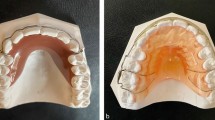Key Points
-
Patient/parent recall of facts discussed during the consent process is generally good.
-
Particular emphasis should be placed on risks of orthodontic treatment at the time of consent.
-
Consent should be considered an on-going process.
Abstract
Objective To determine the level of patient and/or parent recall of previous consent to orthodontic treatment.
Design Patients and/or parents of children who had been consented for orthodontic treatment were asked to complete a questionnaire on consent at least six months into their treatment.
Setting Bristol Dental Hospital.
Subjects and methods Forty-one consecutive patients and eight of their parents, with a combined age range of 12-59 years, with 61% being female and 39% male. The patients, and where applicable their parents, were identified as having previously signed a consent form at least six months previously. Each was asked to complete a questionnaire on aspects of the consent process.
Results Patients and parents demonstrated a high level of recall for the consent process concerning appliance type (89.8%), the reasons for treatment (96%), risks (75.5%), length of treatment (83.3%), the opportunity to ask questions (96%), and whether other information was provided (94%). However, further questioning on risks demonstrated poor recall for important factors such as decay (36.8%), root resorption (less than 21%), retention (56.3%) and length of retention (35%).
Conclusions Overall the consent process works well but specific areas of concern centre around the risks of orthodontic treatment.
Similar content being viewed by others
Log in or create a free account to read this content
Gain free access to this article, as well as selected content from this journal and more on nature.com
or
References
General Dental Council. Standards for dental professionals. London: General Dental Council, 2005.
Re C (adult: refusal of treatment) [1994] 1 W.L.R. 290, [1994] 1 All E.R. 819.
Schloendorff v Society of New York Hospital, 1914. Court of Appeals New York, 211 NY 125 at 126, Lexis-Nexis.
Coreless-Smith D . Consent to treatment. In Lambden P (ed) Dental law and ethics. pp 74–75. Oxford: Radcliffe Medical Press, 2002.
Bristol Royal Infirmary Inquiry. The inquiry into the management of children receiving complex heart surgery at the Bristol Royal Infirmary. London: The Stationery Office Limited, 2001.
The Royal Liverpool Children's inquiry. The Report of the Royal Liverpool Children's inquiry. London: HMSO, 2001.
Department of Health. Reference guide to consent for examination or treatment. London: Department of Health, 2001. http://www.dh.gov.uk/assetRoot/04/01/90/79/04019079.pdf
Chadha N K, Repanos C . How much do healthcare professionals know about informed consent? A Bristol experience. Surgeon 2004; 360: 328–333.
Ibrahim T, Ong S M, Taylor G J . The new consent form: is it any better? Ann R Coll Surg Engl 2004; 86: 206–209.
Byrne D J, Napier A, Cuschieri A . How informed is signed consent? Br Med J 1988; 296: 839–840.
Chatterton v Gerson 1981. 1 All ER 257, 265 per Bristow J.
Askew G, Pearson K W, Cryer D . Informed consent: can we educate patients? J R Coll Surg Edinb 1990; 35: 308–309.
Langdon I J, Hardin R, Learmoth I D . Informed consent for total hip arthroplasty: does a written information sheet improve recall by patients? Ann R Coll Surg Engl 2002; 84: 404–408.
Dobree L . Pre-admission booklets for patients awaiting surgery. Nursing Times 1989; 85: 42–44.
Mortensen M G, Kiyak H A, Omnell L . Patient and parent understanding of informed consent in orthodontics. Am J Orthod Dentofacial Orthop 2003; 124: 541–550.
Lo W, Yap W L . Audit of consent for orthodontic treatment. British Orthodontic Society Clinical Effectiveness Bulletin 2004; 17, 3.
Pearce vs United Bristol Healthcare NHS Trust. [1998] 48 BMLR (CA).
Haines W F, Williams D W . Consent and orthodontic treatment. Br J Orthod 1995; 22: 101–105.
Bolam v Friern. Hospital Management Committee [1957] 2 AIIER 118, 1 WLR 582.
Gorelick L, Geiger A M, Gwinnett A J . Incidence of white spot formation after bonding and banding. Am J Orthod 1982; 81: 93–98.
Mirabella A D, Artun J . Prevelance and severity of apical root resorption of maxillary anterior teeth in adult orthodontic patients. Eur J Orthod 1995; 17: 93–97.
Pratelli P, Gelbier S, Gibbons D E . Lack of knowledge among parents, of the implications of receiving orthodontic treatment. Community Dent Health 1996; 13: 211–214.
Wu W C, Pearlman R A . Consent in medical decision making. J Gen Int Med 1988; 3: 9–14.
House of Lords Judgements – Chester vs Afshar. [2004] UKHL 41. http://www.publications.parliament.uk/pa/ld200304/ldjudgmt/jd041014/cheste-1.htm
Sims A P, Roberts-Harry T J, Roberts-Harry D P. The incidence and prevention of ocular injuries in orthodontic practice. Br J Orthod 1993; 20: 339–343.
Jackson C, Lindsay S . Reducing anxiety in new dental patients by means of leaflets. Br Dent J 1995; 179: 163–167.
Makdessian A S, Ellis D A, Irish J C . Informed consent in facial plastic surgery: effectiveness of a simple educational intervention. Arch Facial Plast Surg 2004; 6: 26–30.
Gauld V A . Compliance and recall. J R Coll Gen Pract 1981; 83: 298–300.
Acknowledgements
The authors wish to thank Dr Gordon Taylor, Senior Medical Statistician, Royal United Hospital Bath for his help with the questionnaire.
Author information
Authors and Affiliations
Corresponding author
Additional information
Refereed Paper
Rights and permissions
About this article
Cite this article
Ernst, S., Elliot, T., Patel, A. et al. Consent to orthodontic treatment – is it working?. Br Dent J 202, E25 (2007). https://doi.org/10.1038/bdj.2007.329
Accepted:
Published:
Issue date:
DOI: https://doi.org/10.1038/bdj.2007.329
This article is cited by
-
Risk management in clinical practice. Part 7. Dento-legal aspects of orthodontic practice
British Dental Journal (2010)
-
Risk management in clinical practice. Part 2. Getting to 'yes' – the matter of consent
British Dental Journal (2010)
-
An audit of the level of knowledge and understanding of informed consent amongst consultant orthodontists in England, Wales and Northern Ireland
British Dental Journal (2008)
-
Consent to orthodontic treatment
British Dental Journal (2007)
-
Continuous consent and dignity in dentistry
British Dental Journal (2007)



